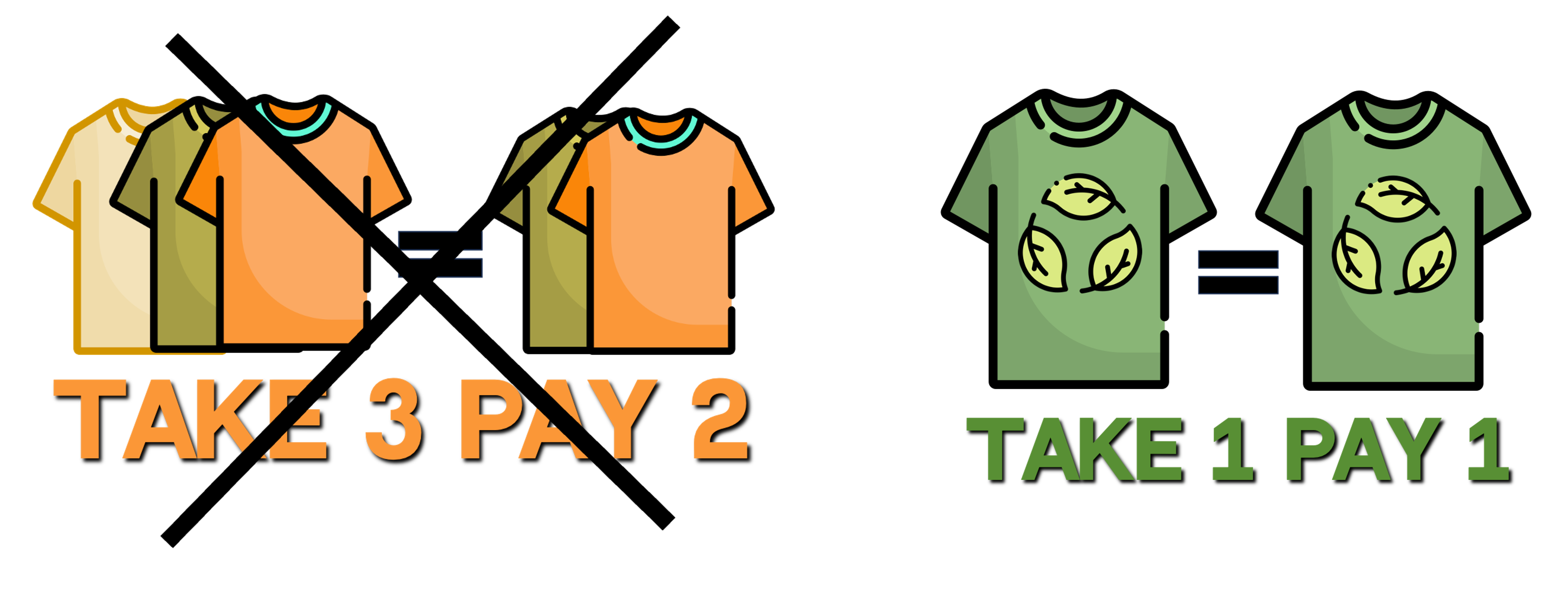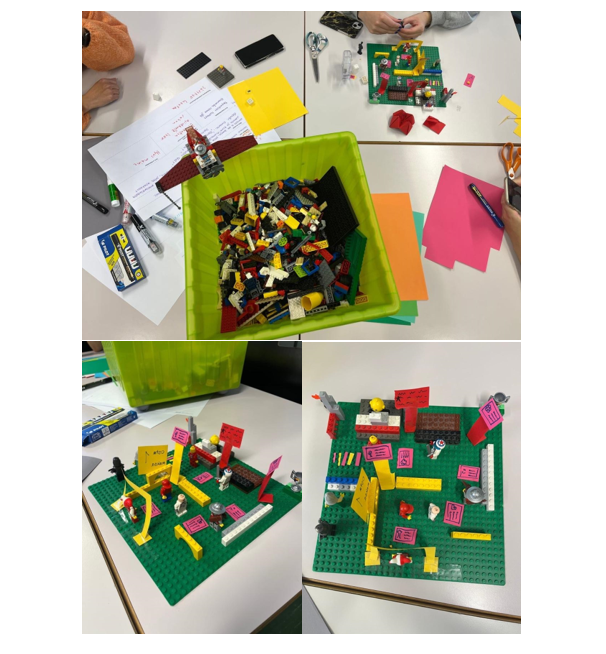Consumer behavior plays a significant role in driving ecological impacts. Encouraging individuals to adopt more sustainable behaviors helps reduce their carbon footprint, raise awareness among consumers, overcome the barriers that prevent them from engaging in sustainable consumer behavior, and so on. One of the most interesting ways to encourage consumers to be more sustainable is by nudging. This article combines design thinking with nudging and discusses the potential of a design thinking workshop for making fashion more sustainable.
 Photo: Eleonora Prits.
Photo: Eleonora Prits.
What is a nudge?
The term ”nudge” describes a concept in behavioral economics that entails subtly influencing people’s behavior without restricting their choices. A nudge is a form of “choice architecture”, a way of designing choices and presenting information to encourage individuals to make better decisions for themselves and for society. Nudges are typically low-cost and non-intrusive interventions. The idea of a nudge is to guide behavior in a positive direction without imposing heavy-handed restrictions (Thaler & Sunstein 2009, 6). A simple example of a nudge in consumer behavior is the placement of healthier food options, such as vegetables and fruits, at eye level in a cafeteria or grocery store so they are in the consumers’ immediate sight.
Workshop as a form of educational nudge
There are plenty of ways of designing, implementing, and testing behavioral change interventions for sustainability (Ceschin & Gaziulusoy 2020, 45). While extensive research has been done on nudging in various areas over the past years, educational scholarship has only recently begun to systematically explore this phenomenon (Damgaard & Nielsen 2018). There are two main views on nudging in educational research. The first view emphasizes the “new promises” of nudging and highlights its potential advantages (Weijers, de Koning & Paas 2021). The second view adopts a critical stance, expressing concerns about the introduction of non-pedagogical stances from behavioral economics into the educational domain (Knox et al. 2020; Williamson 2017).
We suggest looking at a design thinking workshop with students as an “educational nudge”. Despite the relatively recent attention given to nudging in education, workshops stand out as a proactive, subtle, and fun approach to implementing behavioral interventions (Damgaard & Nielsen 2018).
Advocates of nudging in educational settings may find workshops to be a particularly effective tool. Workshops offer an interactive platform that goes beyond theoretical discussions and allows students to gain hands-on, real-life experience. By actively engaging students in discussions and creative activities, workshops can translate nudging principles into real-life actions.
In contrast, critics may reconsider their oppositional view since a well-designed workshop can alleviate some of their concerns. Workshops can be designed to foster critical thinking and reflection instead of being a passive form of nudging. Workshops can give students the opportunities to reflect on the implications of nudging strategies by fostering an atmosphere of open dialog and friendly interaction.
A design thinking workshop for fostering sustainable fashion consumption
A design thinking workshop refers to an interactive and collaborative session that utilizes the principles and methodologies of design thinking to solve problems, foster innovation, and generate creative ideas. Integrating design thinking workshops into education provides an opportunity to take a hands-on approach to raising awareness about sustainable consumption and enhancing possible behavior changes among students while they are designing tools for changing others’ behavior.
The workshop, described in this article, was organized as a part of VISU-project. VISU-project, standing for the “Village for sustainable clothing—bringing together educators, young consumers, and companies”, is financed by the Regional Council of Uusimaa and implemented by Laurea together with the Finnish Textile and Fashion Association (Suomen Tekstiili ja Muoti RY). The project is aimed at bringing together young people, educators, and companies to make clothing consumption more sustainable. The workshop in this study was organized at Business College Helsinki by Laurea’s Service Innovation and Design students Eleonora Prits and Lada Stukolkina.
The aim of this workshop was to combine design thinking with educational nudging. This was a 2-day workshop that demonstrated the potential of design thinking in addressing a sustainability challenge in clothing. The participants of the workshop were 10 students aged 17–19. Participants were given 8 hours to create a solution for addressing the problems of overproduction, overconsumption and nudging consumers to be more sustainable.
During the ideation stage, participants generated creative solutions for the chosen sustainability challenge. They employed brainstorming, mapping, and the ”How could we?” question. The question is a technique to encourage exploration: “How could we convince a consumer to be more sustainable?”. Out of multiple ideas, they chose the strongest one that formed conceptual foundations ready for the prototyping stage. The ideation stage was followed by a hands-on prototyping activity in which participants brought their ideas to life using a variety of materials. This stage allowed them to visualize and to some extent test concepts as well as to reflect on whether the proposed solutions are not only innovative but also feasible and user-friendly.
Solutions for nudging sustainable consumer behavior
Prototype 1. “Magic Clothes” concept.
’The first group focused on creating innovative clothing that grows with the user – “Magic Clothes” concept (Figure 1). They chose the Storyboard method to create a prototype. The Storyboard is a visual storytelling technique used in design thinking to illustrate the user journey or the sequence of events related to a specific problem or solution. The group started by sketching different designs and functionalities on a large sheet of paper, outlining the process of how the garment would transform as the user grows. As they progressed, they used visuals and illustrations to depict the customer experience, providing a complete picture of how it would work in the future (Figure 2).’The first group focused on creating innovative clothing that grows with the user – “Magic Clothes” concept (Figure 1). They chose the Storyboard method to create a prototype. The Storyboard is a visual storytelling technique used in design thinking to illustrate the user journey or the sequence of events related to a specific problem or solution. The group started by sketching different designs and functionalities on a large sheet of paper, outlining the process of how the garment would transform as the user grows. As they progressed, they used visuals and illustrations to depict the customer experience, providing a complete picture of how it would work in the future (Figure 2).
 Figure 1. The first group develops and implements their concept. Photo: Eleonora Prits.
Figure 1. The first group develops and implements their concept. Photo: Eleonora Prits.
The futuristic Magic Clothes growing with the individuals represents an innovative and forward-looking approach to fashion and textiles technology. The participants suggested using smart fibers that seamlessly adjust to the wearer’s body size, eliminating the need for frequent changes. The ability to customize the fit manually or through an application further emphasized the commitment to user-centered design. The students did not describe how such fabric was created, highlighting the speculative nature of their design. However, they believed that this is the kind of clothing that suggests long-term use and reduced environmental impact, as well as inclusivity to accommodate different body types and sizes. Such characteristics of clothing would nudge the owner to be more sustainable.
 Figure 2. Storyboard prototype. Clothes that grow with their owner: illustrating the customer’s experience. Photo: Eleonora Prits.
Figure 2. Storyboard prototype. Clothes that grow with their owner: illustrating the customer’s experience. Photo: Eleonora Prits.
Prototype 2. “Anti-Consumption Store” concept.
The second group was interested in promoting a conscious consumer behavior in the “Anti-Consumption Store”. The group decided to use Lego bricks to build a prototype of such a store, carefully designing every element from product displays to price tags (Figure 3). This tangible representation allowed them to visualize the layout of the store. The concept also incorporated interactive components, such as push-button displays, that introduced facts about (un)sustainability of an (over)consumption and thus, encouraged shoppers to make informed choices.
Departing from traditional retail concepts that stimulate shopping, the Anti-Consumption Store represented a paradigm shift towards responsible retail and conscious consumption. The store had a limited selection and emphasized quality, durability, and sustainability, steering away from the culture of fast fashion. Strategically placed “nudging” messages throughout the store, such as “Buy 1, Pay for 1” or “You look better if you don’t encourage fast fashion”, guided shoppers to make more conscious choices (Figure 4). The absence of stimuli for impulse buying and the inclusion of interactive and educational elements created an environment where shoppers could make more considered decisions. These decisions were supported by the ”Queue Without Impulsivity” feature. This feature is meant to encourage users to make intentional choices rather than impulsive ones when joining a queue or signing up for a particular service.
 Figure 3. The prototype of Anti-Consumption Store built with Lego bricks by the second group. Photo: Eleonora Prits.
Figure 3. The prototype of Anti-Consumption Store built with Lego bricks by the second group. Photo: Eleonora Prits.
 Figure 4. Examples of nudging messages in the store. Photo: Eleonora Prits.
Figure 4. Examples of nudging messages in the store. Photo: Eleonora Prits.
Discussion and Conclusion
Participating in design thinking workshops demonstrated a powerful way to discuss sustainable fashion consumption with students. In the workshop, they were able to reflect on power of design thinking as well as their own consumer choices and the ways of changing them while creating a way to nudge other consumers.
The emphasis on active participation and the development of empathy towards the target group and the topic allowed students to engage directly with the issues and complexities of sustainable fashion. Through hands-on activities and attention to end-user perspectives, students gained awareness of the implications of their design decisions. Collaborative problem solving across teams enhanced the depth and richness of proposed solutions, reflecting a holistic approach to addressing the issue at hand. The emphasis on prototyping and iteration allowed students to go beyond theoretical reasoning to practical solutions. They created tangible embodiments of their ideas, fostering a deeper exploration of design thinking concepts related to sustainable fashion. The design thinking workshop prompted students to reflect on their own values and beliefs regarding sustainability in fashion. The experience serves as a catalyst for a mindset shift, instilling a commitment to prioritizing environmentally and socially responsible fashion choices.
References
- Ceschin, F. & I. Gaziulusoy. 2020. Design for Sustainability: A Multi-level Perspective from Products to Socio-technical Systems. London and New York: Routledge.
- Damgaard, M. T. & H. S. Nielsen. 2018. “Nudging in Education”, Economics of Education Review, 64, 313–342.
- Knox, J., Williamson, B. & S. Bayne. 2020. “Machine Behaviourism: Future Visions of ‘Learnification’ and ‘Datafication’ Across Humans and Digital Technologies”, Learning, Media and Technology, 45 (1), 31–45.
- Thaler, R. & C. Sunstein. 2008. Nudge: Improving Decisions about Health, Wealth, and Happiness. New Haven: Yale University Press.
- Weijers, R. J., de Koning, B. B. & F. Paas. 2021. “Nudging in Education: From Theory Towards Guidelines for successful Implementation”, European Journal of Psychology of Education, 36 (3), 883–902.
- Williamson, B. 2017. “Moulding Student Emotions Through Computational Psychology: Affective LearningTechnologies and Algorithmic Governance”, Educational Media International, 54 (4), 267–288.